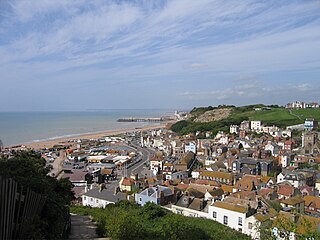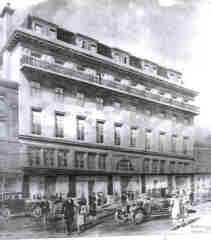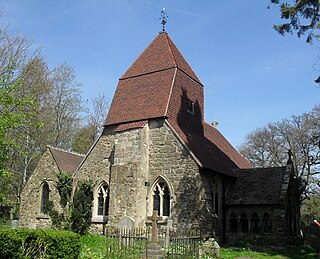
Hastings is a seaside town and borough in East Sussex on the south coast of England, 24 mi (39 km) east of Lewes and 53 mi (85 km) south east of London. The town gives its name to the Battle of Hastings, which took place 8 mi (13 km) to the north-west at Senlac Hill in 1066. It later became one of the medieval Cinque Ports. In the 19th century, it was a popular seaside resort, as the railway allowed tourists and visitors to reach the town. Today, Hastings is a fishing port with the UK's largest beach-based fishing fleet. It has an estimated population of 91,100 as of 2021.

St Leonards-on-Sea is a town and seaside resort in the Borough of Hastings in East Sussex, England. It has been part of the borough since the late 19th century and lies to the west of central Hastings. The original part of the settlement was laid out in the early 19th century as a new town: a place of elegant houses designed for the well-off; it also included a central public garden, a hotel, an archery, assembly rooms and a church. Today's St Leonards has extended well beyond that original design, although the original town still exists within it.

East Sussex College or East Sussex College Group is the largest higher education college in East Sussex, providing education and training from foundation to degree level. The college educates almost half of the county's young people and over 8,000 adults each year at campuses in Lewes, Eastbourne, Hastings and Newhaven, and in the workplace.

The Pilot Field is a football stadium in Hastings, East Sussex. It is home to Hastings United who currently play in the Isthmian League, the club have used the ground since 1985 after the old Hastings United folded, having previously used the ground between 1920 and 1948. The current capacity stands at 4,050 although over 9,000 have been known to attend events in the past and the closure of the grass bank has decreased the capacity.

Henry Ward ARIBA was a British architect who designed many large public buildings in and around Hastings, East Sussex, some of which are listed buildings.

Silverhill is a suburb and local government ward of Hastings, East Sussex, England. It has a central location within the town, where the A21 meets the B2159 road.

Bulverhythe, also known as West St Leonards and Bo Peep, is a suburb of Hastings, East Sussex, England with its Esplanade and 15 ft thick sea wall. Bulverhythe is translated as "Burghers' landing place". It used to be under a small headland called Gallows Head, which was washed away by flooding. The suburbs of Filsham, West Marina and Harley Shute are nearby.

There are 72 Grade II* listed buildings in the city of Brighton and Hove, England. The city, on the English Channel coast approximately 52 miles (84 km) south of London, was formed as a unitary authority in 1997 by the merger of the neighbouring towns of Brighton and Hove. Queen Elizabeth II granted city status in 2000.

The Central Recreation Ground was a cricket ground in Hastings, East Sussex, used for first-class and List A cricket between 1864 and 1996. The ground was frequently used by Sussex County Cricket Club as one of their outgrounds from 1865; in total, Sussex played 143 first-class and 17 List A matches at the ground. Between 1887 and the 1960s, the Central Recreation Ground also played host to the Hastings & St Leonards cricket festival, which attracted many other teams and notable players. In the early twentieth century, the ground hosted seven Gentlemen v Players matches, and notable players to have played at the ground include W.G. Grace, Don Bradman, Jack Hobbs and Denis Compton. Grace made over 40 appearances at the ground, whilst both Hobbs and Compton broke the record for most first-class centuries in a season at the Central Recreation Ground. The ground also hosted a women's one-day international between England and New Zealand in 1984. In the 1980s, planning permission was given for the ground be demolished, and the land used to build a shopping centre. After the demolition of the ground in 1996, the Priory Meadow Shopping Centre was built on the site.

Christ Church is an Anglican church in the Ore area of the town and borough of Hastings, one of six local government districts in the English county of East Sussex. It is one of three Anglican churches with this dedication in the borough. The Decorated Gothic-style church, in the centre of a village which has been surrounded by suburban development, was built in 1858 to supplement Ore's parish church, St Helen's. The most distinctive structural feature, a corner bell turret, has been described as both "outstanding" and "very naughty" by architectural historians. English Heritage has listed the building at Grade II for its architectural and historical importance.

Church in the Wood, officially known as St Leonard's Church and originally as St Rumbold's Church, is an Anglican church in the Hollington area of the town and borough of Hastings, one of six local government districts in the English county of East Sussex. Although Hollington is now a large suburb, consisting mostly of postwar residential development, the church has stood in isolation in the middle of an ancient wood since it was founded in the 13th century—almost certainly as the successor to an 11th-century chapel. Restoration work in the Victorian era has given the Early English Gothic-style building its present appearance, but some medieval work remains. Legends and miraculous events have been associated with the church, and its secluded situation has been praised by writers including Charles Lamb. The church is a Grade II Listed building.

St Leonards-on-Sea Congregational Church is a former Congregational church in St Leonards-on-Sea, part of the town and borough of Hastings in East Sussex, England. Considered "one of the most ambitious Nonconformist buildings in Sussex", the sandstone building of 1863 forms a significant landmark on one of the Victorian resort's main roads—despite the loss of its copper spire in the Great Storm of 1987. Unlike most churches of its denomination, it did not join the United Reformed Church when that denomination was formed in 1972. It fell out of religious use in 2008 and had stood empty and was at risk of demolition. English Heritage has listed the building at Grade II for its architectural and historical importance. Bought by a new owner in 2012 it was almost completely renovated, but was then sold again in 2019. The new owner plans to open the church to the public as an arts and antiques centre with a cafe in the tower.

St Luke's Church is a United Reformed church in the Silverhill suburb of Hastings, a town and borough in East Sussex, England. The congregation was originally independent before taking up Presbyterianism, and worshipped in a private house from its founding in 1853 until a permanent church was provided in 1857; this was one of the oldest Presbyterian places of worship in southeast England. The growth of the community has resulted in several extensions since then, and severe damage caused by the Great Storm of 1987 was quickly repaired—except for the loss of the building's distinctive spire. The church, along with most other Presbyterian congregations, joined the United Reformed Church when that denomination was formed in 1972. It is one of four United Reformed Churches in the borough of Hastings.

St Leonard's Baptist Church is the Baptist place of worship serving St Leonards-on-Sea, a town and seaside resort which is part of the Borough of Hastings in East Sussex, England. The elaborate building was designed by the architectural firm of Thomas Elworthy, responsible for many churches in late-Victorian era Sussex, and serves the residential hinterland of St Leonards-on-Sea—an area which grew rapidly after its early 19th-century founding by James Burton. English Heritage has listed the church at Grade II for its architectural and historical importance.

The Church of St Thomas of Canterbury and English Martyrs is the Roman Catholic church serving St Leonards-on-Sea, a town and seaside resort which is part of the Borough of Hastings in East Sussex, England. The present church, which combines a plain, unadorned Gothic Revival exterior with a lavishly decorated interior featuring extensive early 20th-century paintings by Nathaniel Westlake, is the third building used for Roman Catholic worship in the seaside resort. James Burton's new town of 1827, immediately west of Hastings, was home to a convent from 1848; public worship then transferred to a new church nearby in 1866. When this burnt down, prolific and "distinguished" architect Charles Alban Buckler designed a replacement. The church remains in use as the main place of worship in a parish which extends into nearby Hollington, and has been listed at Grade II by English Heritage for its architectural and historical importance.

All Souls Church is a former Anglican church that served the Clive Vale suburb of Hastings, a seaside resort town and borough in the English county of East Sussex, between 1890 and 2007. The "large [and] serious town church" has been described as one of the best works by prolific ecclesiastical architect Arthur Blomfield. Built almost wholly of brick, inside and out, it dominates the streetscape of the late Victorian suburb and has a tall, "dramatic" interior displaying many of Blomfield's favourite architectural features. The church also has Heaton, Butler and Bayne stained glass and an elaborate reredos. Falling attendances and high maintenance costs caused it to close after a final service in November 2007, and the Diocese of Chichester officially declared it redundant soon afterwards. English Heritage has listed it at Grade II* for its architectural and historical importance.
Shelfield is a hamlet in the parish of Aston Cantlow, Warwickshire. While a small hamlet today, Shelfield was its own manor throughout the 14th and 15th centuries. Containing about a dozen cottages, Shelfield today is best known for its culture of equestrianism, its handful of Grade II listed buildings, and until 2013 it was also a home to the Baron Kilmaine. The name Shelfield has its linguistic roots in Old English words scylf and hyll, which translate as 'shelf' and 'hill' respectively, and so the name could be translated as 'shelf hill' or 'hill with a plateau.' While this Shelfield in Warwickshire is not listed in the Domesday Book, another Shelfield in Staffordshire is mentioned as containing a hide of waste belonging to the Manor of Walsall.

Wellington Square Baptist Church is a Baptist church in the centre of Hastings, a town and seaside resort in East Sussex, England. It was built in 1838 for a congregation which had previously been meeting for worship in hired premises, and it has been in continuous use since then. Rev. W. Barker, a long-serving minister in the 19th century, revived the church after it was split by a secession and later helped to establish Baptist chapels in two other parts of Hastings. The church forms the northwest corner of Wellington Square, one of the town's earliest residential developments, and its stuccoed Neoclassical exterior harmonises with the surrounding houses. Historic England has listed the church at Grade II* for its architectural and historical importance.

St Leonards Pier, also known as the Palace Pier, was a public pleasure pier in St Leonards-on-Sea, part of the town and borough of Hastings in East Sussex, England. Opened in 1891 the pier was a direct rival to nearby Hastings Pier, and during its heyday the pier was a leading tourist attraction, and was described in the 1894 Baedeker travel guide as handsome. The pier was damaged during WW2 and left derelict after the war until purchased by Hastings Corporation in 1951 who demolished the structure over the next two years.


















